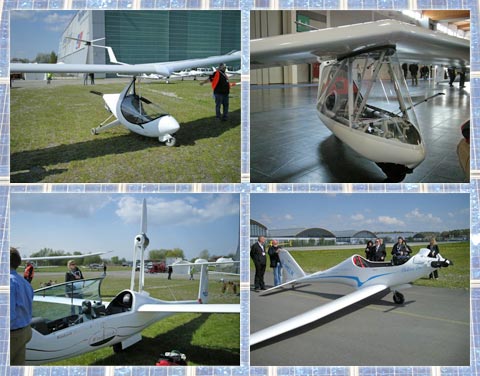
In May 1811, a tailor in the town of Ulm, Germany, built a hang glider and tried to fly it across the Danube. He didn’t make it. He crashed into the river and was “scorned and ridiculed,” according to Ulm history. “His aircraft was airworthy in principle—just not above the Danube, where air currents were particularly unfavorable at the time of his attempt,” the story goes. But though he had been just a few notches above the tower-jumpers of the Middle Ages, the tailor—Albrecht Berblinger—lives on in today’s Berblinger Flight Competition, an eco-flying contest of sorts.
The competition, sponsored by Ulm, was held this year at Aero in Friedrichshafen, Germany. It included 15 aircraft powered by eco-friendly powerplants—be they solar or electrical.
At first, the objective was to fly from the Friedrichshafen airport to Ulm and back. But strong, gusty winds ruled this out; the lightly wing-loaded and low-powered aircraft would have too difficult a time of it. And safety considerations were paramount. So a form of handicapping emerged, whereby each airplane’s performance was judged according to its perceived strengths. For some aircraft, this meant meeting a time-to-climb threshold. For others, aircraft battery capacity and endurance were factored in. This meant competition flights of varying lengths of time, because each airplane has its own endurance profile according to its battery, propulsion system, and drag.
The 16 politicians, Ph.D.s, and professors making up the jury will choose the winner of the $140,000 Berblinger prize based on a 100-point evaluation scorecard that emphasized each design’s skill at “demonstrating the versatility that could determine the future of aviation,” according to an official document.
The competitors walked their steeds out of an exhibit hall, down a taxiway, and onto a grass runway that paralleled Friedrichshafen’s Runway 6/24. One by one, they launched into a sporty left crosswind. No matter the design, liftoff came in a matter of a hundred feet or so, climb rates were impressive, and … the airplanes were almost silent.
One of the competing airplanes—Eric Raymond’s solar-powered Sunseeker II—has been flying since 1989, and had demonstrated superb cross-country capability. Others, such as the PC-Aero Elektra One, were relative newcomers. In between were the electrically powered, weight-shift trikes such as the Pit-trike, and electrically powered motorgliders such as the Silent Glider, the Windreich Arcus-E, and the Antares 20E. The latter three designs were equipped with retractable motors and propellers, as well as manually retractable, single landing gear installations.
Though well-planned, there was an ad-hoc, spontaneous nature to the Berblinger event reminding this author of the charmingly quirky, informal aspects that distinguished the early hang gliding competitions in the late 1970s and early 1980s in California. Sure, there was competition, but lasting friendships were forged, designs were refined, and all were united in the pursuit of a new method of flying. The billow-cruiser, pure-delta wing Rogallo-style hang gliders gave way to more rigid, cambered, higher aspect ratio wings with trailing edge devices that prevented the deadly “full luff” dives of 10 years earlier.
Someday, competitions like this year’s Berblinger will no doubt be similarly remembered. Does solar beat electrical for endurance? When will truly long-endurance batteries be developed? Will sailplanes augmented by electrical power supplant traditional motorgliders? What’s the optimal airfoil for “green” propulsion systems? Will electrically powered light sport aircraft become mainstream? Competitions like the Berblinger will help answer those questions. But not right now. As of this writing the judges were still deliberating and the prize winner had yet to be announced.

